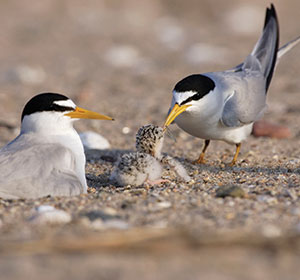
Audubon Adventures
Seabirds: Feathered Ocean Mariners

Activities
 Activity 1
Activity 1
Just Beak It!

 Teacher-led Classroom Activity
Teacher-led Classroom Activity
Science/Inquiry/Research
How are seabird beaks adapted to the foods they eat?
Objective:
Students model beak adaptations in seabirds by grasping different objects with a variety of tools.
Students will need:
- Tools: 3 pairs of pliers, 3 tweezers, some toothpicks, 3 teaspoons
- Foods: puffed cereals, uncooked shell macaroni, gummy candy, banana
- Three dish tubs or large bowls
- Knife for cutting banana
- Water
- Clay
- Index cards
- Images of seabird beaks from field guides, books, or online
Suggested time:
One class period for activity, plus setup time.
What to do:
- Before the classroom activity, set-up these three Seabird Feeding Stations. (If the class is large, consider having two or three of each.)
- Seabird Feeding Station FISH: Fill a dish tub or large bowl half-full with water. Peel and thinly slice a banana, then cut the slices into half circles. Add the slippery banana slices to the water.
- Seabird Feeding Station MOLLUSKS: Make two or three balls of clay and stick them onto the bottom or sides of another dish tub or large bowl. Press a number of gummy candy pieces and shell macaroni into each ball of clay. Fill the dish tub or bowl half-full with water.
- Seabird Feeding Station MACROPLANKTON: Fill a dish tub or large bowl half-full with water. Sprinkle some puffed cereals on top of the water.
- Set a pair of pliers, a teaspoon, tweezers, and a few toothpicks at each station.
- Use folded index cards to make a label for each Seabird Feeding Station, but do not place them yet.
- Prepare students for the activity by making connections between the feeding stations and seabird foods. Challenge them to guess what kinds of food each station represents, then set an appropriately labeled index card next to the station before moving to the next. Check for understanding of the terms mollusk and macroplankton.
- Help students to start making connections between the tools and the actual beaks of seabirds, too. Invite students to name different seabirds they know and discuss what they might eat and how each is adapted to its particular food. If you feel student understanding is high, challenge them to say which of the tools is most like the beak of that specific seabird.
- Organize the class into small groups of 3-4 students. Have each group take a turn at each feeding station trying to capture food with the available tools. Use a stopwatch or clock to move the process along, asking groups to rotate to the next station (or sit down) after 2-3 minutes.
- Once all the students have visited all three stations (every student doesn’t need to have used every tool at every station) have a discussion about which “foods” were easy to catch with which “beaks.” Which food and beak combinations were unsuccessful?
- Consider generating a data chart by having the class vote on a 1-3 rating for each combination food-beak combination, with 1=difficult and 3=easy. Create a chart of foods and beaks on the board to keep track of the votes, like this:
Photos: (t to b) Jean Hall; Paul Tessier/iStock




